#Russian Tu-154
Explore tagged Tumblr posts
Text

A Russian Air Force Tu-154M climbing into cloudy skies as it departs Geneva International Airport
#Russian Air Force#Tupolev#Tu-154#airliner#transport#passenger jet#plane#airplane#aviation photography#aircraft
10 notes
·
View notes
Text

Aeroflot planes - vintage postcards (1983)
Top: TU-154
Bottom: IL-86
Good vintage condition, a bit of handling wear. Unused, blank on the back side with Aeroflot logo (the Soviet airline).
Available in my shop for $3.50/each + $5 shipping (registered, by Russian Mail).
Currently shipping from St Petersburg.
Message me if you want to buy this. Currently available items. I combine shipping. How to buy
54 notes
·
View notes
Text

airsLLide No. 17334: RA-65046, Tupolev 134A-3, Bashkirian Airlines, Ufa, August 18, 1999.
Leased from Perm Airlines and thus featuring a hybrid paint-job, Tupolev 134A-3 RA-65046 sits in front of Bashkirian's maintenance base at Ufa, the capital of the Russian republic of Bashkortostan, on the Western foot of the Ural mountains.
Compared to other maintenance buildings across Russian airports that can have the charming looks of a 1950's steel mill lost in time, the hangars at Ufa look fairly modern. Construction of the current airport took place in the mid 1960s, and maintenance facilities to accommodate planes up to the size of the Tupolev 154 were added in the mid 1970s.
On the occasion of the brief visit above, getting a glimpse on the ramp and inside the hangar, Bashkirian maintenance was busy handling three Tu-134s and two of their Tu-154B, the latter aircraft type being the backbone of the fleet, used to run the twice-daily trunk route service to Moscow-Domodedovo as well as international flights.
3 notes
·
View notes
Text

Russian cargo aircraft would be making secret flights to North Korea, allegedly looking for missiles
Fernando Valduga By Fernando Valduga 03/30/2024 - 21:15 in Military
A huge An-124 cargo plane with an alleged history of North Korean weapons smuggling was tracked back from an apparent mission to seek more short-range ballistic missiles (SRBMs) provided by the Kim Jong Un regime.
A recent report by Colin Zwirko of NK News shed light on secret flights conducted by two Russian military aircraft to North Korea.

Russian An-124 (RA-82030) returning to Vladivostok from North Korea in the early hours of March 21, 2024 (Photo: Flightradar24 screenshot)
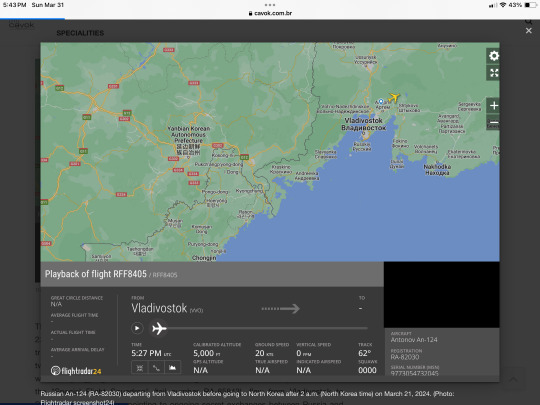
Russian An-124 (RA-82030) departing from Vladivostok before going to North Korea after 2 a.m. (North Korea time) on March 21, 2024. (Photo: Flightradar screenshot24)
The flight tracking data analyzed by Zwirko suggest that a Russian cargo plane An-224 (tail number RA-82030) - one of the largest transport aircraft in the world - was traveling from the DPRK towards Vladivostok, east of the shared border coast of the two countries at 6:47 a.m. (North Korea time) on March 21. It is likely that the plane went to Pyongyang, since another Russian government aircraft, a Tupolev Tu-154 of the "Special Flight Squadron" (tail number RA-85843), flew from Vladivostok to Pyongyang hours earlier, pointing to ongoing secret exchanges between Russia and North Korea.
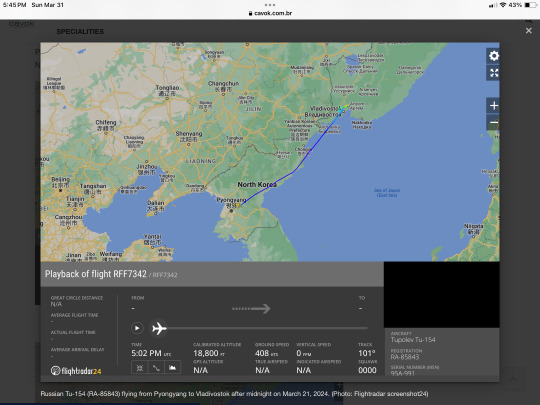
Russian Tu-154 (RA-85843) flying from Pyongyang to Vladivostok after midnight on March 21, 2024. (Photo: Flightradar screenshot24)

Russian Tu-154 (RA-85843) flying from Pyongyang to Vladivostok on the afternoon of March 22, 2024. (Photo: Flightradar screenshot24)
This plane departed from the Russian city of the Far East just before midnight on March 20, before landing in Pyongyang after 12:24 a.m. (North Korea time) on March 21. He then left Pyongyang for Vladivostok less than two hours later, about the same time the cargo plane left Vladivostok. Then he turned off the transponder and disappeared from tracking, a common practice for Russian aircraft and cargo ships that were sighted in North Korea. Flights with the Tu-154 did not have their transponder turned off to Pyongyang.
According to the NK News report, several other flights were observed on monitoring sites.
Of particular interest is the involvement of the 224ª Flight Unit and the An-124 cargo plane with tail number RA-82030, which were previously implicated by the U.S. Treasury Department in sanctions related to the transfer of ballistic missiles from the Democratic People's Republic of Korea. Despite these allegations, the precise nature and timing of such transactions remain unknown.

Tupolev Tu-154 (RA-85843).
The US and South Korea accused the Kim Jong Un regime of providing the Kremlin with missiles, artillery grenades and other weapons to replenish the Russian armed forces while it uses equipment and ammunition in its invasion of Ukraine. Both Moscow and Pyongyang denied that such transfers are taking place.
The recent flight activity coincides with the escalation of tensions in the region, following the North Korean ballistic missile test conducted by leader Kim Jong Un. Although the specific cargo carried by the Russian aircraft remains unknown, intelligence reports suggest the potential transport of short-range ballistic missiles (SRBMs).
The ability of the An-124 cargo plane to carry large and heavy weapon systems further amplifies the seizures around the purpose of these secret flights.

South Korea's Chosun News TV reported on the cargo plane on Saturday, citing a comment from an anonymous source of "ROK-US intelligence authority", but not including details such as model, final number or moment.
The source would have said that intelligence agencies caught the plane carrying 15-meter-long cargo "supposedly SRBMs". Allegedly, these were Hwasong-11 series missiles (KN-23).
The apparent stop of the aircraft in Pyongyang occurred a few days after the North Korean supreme leader, Kim Jong Un, presided over his country's first ballistic missile test in two months.
Tags: Antonov An-124 RuslanMilitary AviationNorth KoreaRussian Air ForceTu-154
Sharing
tweet
Fernando Valduga
Fernando Valduga
Aviation photographer and pilot since 1992, he has participated in several events and air operations, such as Cruzex, AirVenture, Dayton Airshow and FIDAE. He has works published in specialized aviation magazines in Brazil and abroad. He uses Canon equipment during his photographic work in the world of aviation.
Related news
INTERCEPTIONS
Italian Eurofighters in Poland perform two interceptions of Russian aircraft in less than 24 hours
30/03/2024 - 20:19
Two U.S. Air Force B-1B Lancers during the 24-2 Bomber Task Force at Morón Air Base, Spain. (Photo: Scott Rathbone / Flickr).
MILITARY
Two more B-1B bombers are deployed in Spain
30/03/2024 - 15:30
MILITARY
Ecuadorian Air Force receives a C-130 Hercules donated by the US
30/03/2024 - 14:00
MILITARY
Royal Dutch Air Force releases F-16 fighters from QRA task
30/03/2024 - 11:14
HELICOPTERS
North Macedonia formalizes order for Leonardo's helicopters
30/03/2024 - 10:38
Greek Air Force F-16 Block 30 fighters.
MILITARY
Greece is selling its oldest F-16 and Mirage 2000, but will any country buy them?
29/03/2024 - 20:00
4 notes
·
View notes
Text

Tupolev Tu-154M Donavia
Registration: RA-85626 Type: Tu-154M Engines: 3 × D-30КU-154 Serial Number: 0753 First flight: 1987
Donavia, a former Russian airline, was a division of Aeroflot and operated domestic and international flights from southern Russian cities. Donavia's base airports were located in Rostov-on-Don, Krasnodar, Sochi and Mineralnye Vody. The company's head office was located in Rostov-on-Don. The Rostov United Aeroflot Squadron was founded on June 15, 1925, which later became one of its largest divisions. In 1993, squadron was reorganized into Don Airlines (Donavia). In the spring of 2000, Donavia, with the support of Aeroflot, founded the airline Aeroflot-Don, but in 2009 the airline returned to its former name Donavia. In 2016, the airline was integrated into Rossiya Airlines.
Poster for Aviators. aviaposter.com
#tu154#т��154#туполев#туполь#tupolev154#ttail#trijet#avgeek#aviationart#giftforpilot#soviet aircraft
2 notes
·
View notes
Text

The following are the contents of the article, including a description of the infobox, listed in succession.
(title of infobox in Chinese and Manchu languages) Chinese Imperial Air Force (English) 中華帝國空軍 (Hanzi) Chung-hua Ti-kuo K'ung-chün (Wade-Giles, the most widely used Chinese romanization system in this timeline)
(Below is the name in Manchu script, it only renders sideways here) ᡩᡠᠯᡳᠮᠪᠠᡳ ᡤᡠᡵᡠᠨ ᡳ ᠠᠪᡴᠠᡳ ᠴᠣᠣᡥᠠ (Manchu) Dulimbai gurun-i Abkai Cooha (Manchu romanization)
Emblem of the Chinese Imperial Air Force:
Symbol consisting of the roundel with a blue-green-white-red dragon flying around the central red sun, vertical red and yellow banners with the name of the air force in white Hanzi and Manchu script, two outspread white bird wings, and the red imperial crown of the Great Qing Emperor
Founded: 10 August 1910; 113 years ago (as Army Flying Corps) 25 December 1929; 93 years ago (as current service)
Country: China Type: Air force
Role: Aerial warfare Airborne forces Air defense
Size: 300,000 active personnel (2023) 4,000+ aircraft (2023) Part of: Chinese Imperial Military Headquarters: Peking (this spelling remained popular in the English-speaking world) Motto(s) 盡忠報國 English: "boundless loyalty to the country" (the text of Yue Fei's famous tattoo) Colors: Blue, yellow, red (a medium cerulean blue, a slightly warm yellow, and a bright cherry red)
March: Quick: Dragon Aviators' March Slow: Five Thousand Years Anniversaries: Air Force Day (14 August) Aviation Day (10 August)
List of Engagements: Late Kuang-hsü Crisis
(Second Canton Revolt)
(Wu-ch'ang Rebellion)
(Hatchet Gang Rebellion) Sino-German War First World War Russian Civil War
(West Siberian Intervention) Warlord Era
(Imperial Protection War)
(Yün-Kwei War)
(Southern Expedition)
(Sinkiang Campaign) Outer Mongolia Insurgency Second Sino-Japanese War Second World War Chinese Civil War
(Tai-wan Strait Crisis) Korean War
(Yalu-Tumen Intervention) Sino-Indian War
(Battle of Bhutan) Tibet Uprising (1959)
(Operation Wind Shadow) Third Indochina War
(Operation Phoenix Eye) Spratly Islands Conflict Indonesia-Malaya War
(Operation Celestial Spear) Uzbekistan War
(Operation Black Tortoise)
Website: (Official website link)
Commanders: Commander-in-Chief: Jui-wen Emperor (era name 睿文, means "Forward-thinking culture") Director of the IDC: Li Kuo-t'ai Minister of War: Marshal Fan Sung-yün Chief of the Air Staff: Marshal Wei Chao-lin
Insignia: Roundel: Concentric circles of blue, yellow, and red, with a thin ring of blue on the outside, a large area of yellow inside it, and a small red circle at the center Fin flash: high visibility, Blue-Yellow-Red tricolor, low visibility yellow and red alone. Ensign: Black Ensign with Qing imperial flag in the canton. In the black field are depictions in white of the Little Dipper and the North Star, arranged in an arc from the middle fly to the lower hoist. The black field represents the night sky and commemorates the air force's famous night raids during World War II.
Aircraft flown: Bomber: Hsi-an JH-7, H-6 Electronic warfare: Russo-Balt RB-154, Shan-hsi Y-8, Shan-hsi Y-9, J-16D Fighter: Chʻêng-tu J-7, Mukden J-8, Chʻêng-tu J-10, Mukden J-11, Mukden J-16, Chʻêng-tu J-20, Samara Sa-27, Sa-30MKK, Sa-35S Helicopter: Harbin Z-8, Harbin Z-9 Attack helicopter: Harbin Z-19, CAIC Z-10 Utility helicopter: Harbin Z-20 Interceptor: Mukden J-8 Trainer: K'un-lun L-15, K'un-lun JL-8, JL-9 Transport: Hsi-an Y-20, Shan-hsi Y-9, Shan-hsi Y-8, Hsi-an Y-7, Zhukovsky Zh-76 Tanker: H-6U, Zh-78
Chinese name in various transcriptions used in this world: Traditional Chinese 中華帝國空軍 (used on the mainland) Simplified Chinese 中华帝国空军 (used on Tai-wan) Literal meaning: Chinese Imperial Air Force Bopomofo: ㄓㄨㄥ ㄏㄨㄚˋ ㄉㄧˇ ㄍㄨㄛˇ ㄎㄨㄥ ㄐㄩㄣ Wade–Giles: Chung-hua Ti-kuo K'ung-chün Cantonese Jyutping: Zung-waa dai-gwok Hong-gwan
(Below is the separate box for further reading on the Qing military that accompanies the main infobox in most such articles)
Armed Forces of the Great Ch'ing Empire Octagonal symbol known as "the Eight Corners" containing the colors of all the Eight Banners arranged to resemble the character 卐 (Wan, important to state-sponsored Vajrayana religion)
Executive departments:
Imperial Defence Council
Ministry of War
Staff:
Director of the IDC
General Staff of the Military
Works Department of the IDC
Censorate of the IDC
Services:
Chinese Imperial Military
Army
Navy
Air Force
Strategic Support
Independent troops:
Military Police Force
T'uan-lien Militia
Pao-chia Guards
Eight Banners
Special operations force:
Special Operations Department
Special Police Unit of the MPF
Snow Leopard Commando Unit
Mountain Eagle Commando Unit
Other troops:
CIM Joint Logistics Support Force
Military districts:
Eastern Theater Command
Southern Theater Command
Western Theater Command
Northern Theater Command
Central Theater Command
History of the Chinese military
Military history of China
Military ranks of China
Ranks of the Imperial Army
Ranks of the Imperial Navy
Ranks of the Imperial Air Force
(Main body of the article below here)
The Chinese Imperial Air Force (CIAF; Chinese: 中華帝國空軍; Wade–Giles: Chung-hua Ti-kuo K'ung-chün), also referred to as the Chinese Air Force (中華空軍) or the Imperial Air Force (帝國空軍), is the principal aerial service of the Great Ch'ing Empire, a part of the Chinese Imperial Military along with the Imperial Navy and the Imperial Army. The CIAF was officially established on 25 December 1929 and it is composed of five branches: aviation, ground-based air defense, radar, Airborne Corps and other support elements.
The development of the CIAF began with the creation of the Pei-yang Army Flying Corps in 1910, which flew French biplanes in reconaissance and bombing operations against rebels. With the splintering of the Pei-yang Army in 1916, elements of the Flying Corps entered the service of the various warlords vying for control of the government. During the First World War, ten bombers were shipped to Shang-hai for the Peking Government's use in dislodging the German Navy from Kiautschou Bay. The Flying Corps would participate in the Southern Expedition using primarily the Avro Avenger fighter aircraft and the Avro Aldershot heavy bomber provided by the United Kingdom, and in 1929, with the warlords brought together or defeated, the Air Staff was created as a separate branch of the military. The UK also assisted with the expansion of the Chinese aerospace industry during the Second Sino-Japanese War. Changes in the organization of the CIAF followed by modernization programs in the 1980s and increased technology development in the 21st century resulted in the J-20 stealth multirole fighter, the first of its kind for China.
The Air Force's mission is to secure the objectives of the Imperial Defence Council which are to "provide necessary security and defense of the Empire and to support the Government's international obligations". The highest-ranking military officer in the Air Force is the Chief of the Air Staff, who exercises supervision over Air Force units, while the IDC assigns Air Force components to unified combatant commands. Some units are also ceremonially affiliated with the Eight Banners, but since 1931 have been functionally integrated into the civilian command structure. The Helicopter Command contains most of the rotary-wing aircraft of the CIAF. Most of the air force is based in Mainland China, but some units do serve on foreign operations (principally over Manipur and Bukhara) or at long-established foreign bases (Havana, Ream, Djibouti, and Gorno-Badakhshan). Although the CIAF is the principal Chinese air power arm, the Imperial Navy's Fleet Air Corps and the Army Air Corps also operate armed aircraft.
Contents: 1 History 1.1 Origins 1.2 Warlord Era and Yüan Ch'en 1.3 First United Front 1.4 Second Sino-Japanese War 1.5 Chinese Civil War 1.6 Korean War to the Sino-Russian Split 1.7 1970s to 1980s 1.8 P'ing-hsiang era (平祥, Peaceful and Auspicious) 1.9 Jui-wen era 2 Personnel 2.1 Ranks and insignia 2.2 Commanders 3 Structure 3.1 Senior leadership 3.2 Headquarters 3.3 Commands 3.3.1 Transport command 3.3.2 Long-range command 3.3.3 Expeditionary command 3.3.4 Training and research 3.4 Order of battle 3.5 Airbases 3.6 Aerobatic display team 4 Aircraft 4.1 Combat air 4.2 Intelligence 4.3 Maritime patrol 4.4 Helicopters 4.5 Training aircraft 4.6 Advanced jet training 5 See also 6 References 6.1 Citations 6.2 Sources 7 Further reading 8 External links
History: (Further information: link to page "Aviation in China")
Origins:
Today's Chinese Imperial Air Force (CIAF) traces its roots back to August 10, 1910 when the government authorized the creation of the Army Flying Corps in an effort to improve intelligence and gain the upper hand on insurrections. On the same day, construction began on Peking Nan-yüan Airport as part of a program to modernize national infrastructure. Initiated in the wake of the Boxer Protocol in 1901, the Keng-tzu New Policies were ordered by the Empress Dowager Tz'ŭ-hsi to reform government bureaucracy along with the military, and by the start of the Hsuan-t'ung reign a group of preparatory departments had been organized for experimentation with new technology and administrative systems. In 1903 an imperial edict expanded the Wu-wei Corps to 36 divisions, creating the Pei-yang Army, in 1905 the Imperial Examinations were abolished, and in 1907 a new law code and judicial system were rolled out. That same year, the tax code was reformed and the rail system was nationalized, which greatly helped the empire's finances but caused significant unrest as well.
With the death of Jung-lu in 1903, General of the Right Division Yüan Shih-k'ai became commander of the Pei-yang Army. His role in the 1898 coup d'état against the Kuang-hsü Emperor made him many enemies, and when the empress dowager and the emperor died within a day of each other in 1909, he was forced to resign by Prince Ch'ün and return to his home village ostensibly for health reasons. In spite of this, Yüan remained in communication with his associates in the army. In the wake of the February 1910 Keng-hsü Army Uprising, he authorized the Pei-yang Army to found a flight school at Nan-yüan to train a group of eight pilots to fly reconnaisance using Cauldron Type D biplanes purchased from France, improving the army's ability to respond. In early 1911, the Aviation Research Institute was founded.[6]
Warlord Era and Yüan Ch'en:
(Photo labeled "Nan-yüan Air Force Academy drillmasters in front of Avro aircraft") (Photo labeled "Voisin V in Shang-hai")
In 1911, a major popular uprising began in Canton while another army mutiny occurred at Wu-ch'ang. In a panic, Empress Dowager Lung-yü convinced Yüan to come out of retirement and lead the war effort in exchange for the position of Prime Minister and the final adoption of the Hsuan-t'ung Constitution. The rebellion was crushed by the end of 1912, and the T'ung-meng-hui (TMH) revolutionary society was forced to flee to Japan once again with numerous dead. With the south pacified, Yüan feared he would no longer be of use to the Ch'ing court. In spite of the bureaucrats' protests, he brought his army into the capital in order to protect himself and his allies from execution, essentially holding the court hostage. For five years, he and his majority Han chinese cabinet ruled the country.
Reasoning that China desired a new Han-ruled dynasty, Yüan revised the constitution to make himself a dictator before announcing plans to seize the throne as the Hung-hsien Emperor of Great Ch'en, allowing his army to plunder Manchu estates as northern Chinese cities descended into racial violence. The Ch'ing court fled to Gan-su, where support for Han rule was lower, under the protection of Ma An-liang and Shaan-hsi governor Ch'ien Neng-hsün. With the divided country now in civil war, many of Yüan's closest supporters abandoned him, and the solidarity of his Beiyang clique of military protégés dissolved. The Hung-hsien Emperor was opposed by not only the Ch'ing and the minorities, but far more importantly by his subordinate military commanders, who believed that his usurpation would allow him to rule without depending on the support of the military.
A coalition of governors and officers led by An-hui governor Liang Tun-yen launched the Imperial Protection War against him, officially in the name of the Hsuan-t'ung Emperor, while the Air Corps rebelled as well and dropped bombs on the Forbidden City. Yüan's health continued to decline, and his death in 1916 paved the way for the return of K'ang Yu-wei and other anti-Yüan reformist exiles. The Prince Ch'ing Cabinet retook control of the capital, denouncing Yüan and purging his allies, while government authority was greatly damaged. Provinces broke away and the TMH returned in 1917 to start a Han-nationalist insurgency in Hunan.
The fall of Yüan Shih-k'ai created a power vacuum and fractured the army. Fearing for their lives, many of the southern Pei-yang generals revolted and took control of the provinces as military governors. Minister of War Wang Shih-chen, nominally in charge of the Pei-yang Army, abolished it and reorganized the loyalist forces into the Chinese Imperial Military. Expanding the airbases at Nan-yüan and Ta hsiao-ch'ang, Marshal Wang was able to acquire more machines from Britain and France when the new army attacked the German Leased Territory of Kiautschou Bay in 1917 and China was drawn into the First World War.
As part of the allied Operation Asher, ten Voisin V pusher bombers were produced in France and shipped to Shang-hai. In spite of having defeated the 1914 allied attack, by this time the garrison was low on supplies and the Chinese aircraft proved devastating to German morale during the Second Siege of Tsing-tao. An avid aviation enthusiast, the Hsuan-tung Emperor himself also took great interest in the development of the Air Corps, and when he assumed direct rule in 1924 he personally invested large amounts of his constitutional subsidy into it.
First United Front:
During the late 1920s, the Ch'ing Imperial Government formed the first united front with the liberal T'ung-meng Hui (TMH) party against competing warlords in a bid to reunite a fractionalized China, combining the liberal Wu-han Government with the Imperial Assembly. In this period, various airplanes were purchased and deployed by warlords in their struggle for power until nominal Chinese reunification in 1929 following the Southern Expedition which saw the use of Avro Aldershot heavy bombers to inflict serious damage on the infrastructure of several provinces in support of the government offensives. That year, the CIAF was designated as an independent branch of the armed forces. The eighteen graduate pilots of the military flight school included nine republican and nine monarchist pilots who were sent to the Russian Federation for two years of advanced flight training under the tutelage of the more experienced Russian Air Force. Two of the imperial graduates, Kuo Tzu-han and Sung Chien-yü, continued to serve in the Russian Air Force for five years until, in September 1928, they returned to Ti-hua as instructors.
At the same time, Tsai-chen the fifth Prince Ch'ing established the Bureau of Aeronautics in 1920. Subsequently, the organization continued to develop, and successively established an aircraft factory, an aviation command, and a new aviation school in Hsi-an. In May 1927, the Aviation Department of the Ministry of War was changed to the Aviation Committee of the Defense Council of the Imperial Government. By 1929, the government's aviation force was officially independent from the Army General Command and became an independent service.
Second Sino-Japanese War:
(Photo labelled "Self-developed Chinese transport aircraft during the Battle of Ch'ang-sha")
Following the abolition of many of their social privileges in the Hsin-wei Reform Act, many Banner families experienced poverty and violence. In response to perceived neglect, they became disaffected with the Hsuan-t'ung Emperor. Some sided with the northeastern Pei-yang Army generals of the Fêng-tʻien Clique, while some sought support from Imperial Japan.
A minor dispute known as the Wan-pao-shan incident between Han and Korean farmers occurred on July 1, 1931. The issue was highly sensationalized in the Imperial Japanese and Korean press, and used for considerable propaganda effect to increase anti-Chinese sentiment in the Empire of Japan. Believing that a conflict in Manchuria would be in the best interests of Japan, Kwantung Army Colonel Seishirō Itagaki devised a plan to provoke Japan into invading Manchuria by setting up a false flag incident for the pretext of invasion. The Independent Garrison Unit of the 29th Infantry Regiment (which guarded the South Manchuria Railway) placed explosives near the tracks, but far enough away to do no real damage.
On the morning of September 19, two artillery pieces installed at the Mukden officers' club opened fire on the Chinese garrison nearby, in response to the alleged Chinese attack on the railway. Chang Hsueh-liang's small air force was destroyed, and his soldiers fled their destroyed Pei-ta-ying barracks, as five hundred Japanese troops attacked the Chinese garrison of around seven thousand. The Chinese troops were no match for the experienced Japanese troops. By the evening, the fighting was over, and the Japanese had occupied Mukden at the cost of five hundred Chinese lives and only two Japanese lives, thus starting the greater invasion of Manchuria. By 1932, most of the region was under Japanese control and the Empire of Manchukuo was created, while a young member of the Hitara clan was enthroned in Ch'ang-ch'un as the K'ang-te Emperor.
The CIAF immediately dispatched combat aircraft to the Hung-ch'iao Aerodrome during the January 28th Incident of 1932, and aerial skirmishes occurred for the first time between China and the Imperial Japanese. In February 1932, US Reserve Lt. Robert McCawley Short, who was transporting armed Chinese aircraft, shot down an IJN aircraft on February 19, 1932, and downed another on February 22 before he was killed (he was posthumously raised to the rank of colonel in the CIAF). During the early days of China's war of resistance against the Japanese invasion, the Imperial Air Force participated in several battles, including attacking Imperial Japanese Navy warships along the Yangtze River and supporting the Battle of Shang-hai. By this time, the Imperial Air Force's main fighter models were the Curtiss Hawk II and Hawk III fighters. On August 14, 1937, Japanese Imperial Navy bombers bombed Hang-chou Chien-ch'iao Airport, but was defeated by the CIAF; therefore, August 14 was designated as Air Force Day by the Imperial Government. In May 1938, the CIAF dispatched two B-10 bombers to Japan to drop leaflets.
By the middle of the war, intelligence units of the Imperial Japanese Navy cracked the radio codes of the Chinese army, putting the Air Force under attack. In the middle and late stages of the Second Sino-Japanese War, the addition of Chennault and other foreign pilots, as well as the support provided by the United States after joining the Allies, restructured the combat power of the CIAF and participated in the Hsin-chu Air Attack, and air raids on Japan. After the end of World War II, in June 1946, the Aviation Committee of the Military Committee of the Imperial Government was changed to the General Command of the Air Force.
Chinese Civil War:
In January 1941, as intensifying clashes between imperial and TMH forces ended the second united front against invading Japanese forces, the government's Imperial Defense Council (IDC) established the Air Force Engineering School with Kuo as commandant and Sung as head instructor. In May 1944, just over a year before the Japanese surrender to Allied forces, the IDC established an Aviation Section in Hsi-an with Kuo as its director and Sung as deputy director. Two years later in May 1946 and after the withdrawal of Japanese troops, the IDC established the Northeast Old Aviation School in Kirin. By 1949 the Aviation Section of the IDC had 560 trained personnel (125 pilots and 435 ground support specialists), purchased 435 aircraft from the Russian Federation, acquired 115 republican aircraft, and operated seven military flight schools.
During the Second Civil War between the T'ung-meng Hui and the Imperial Government from 1946 to 1949, the Air Corps of the Republic of China participated in combat support and air strikes against the CIAF on the mainland and around the Tai-wan Strait. In October of the same year, the ACROC assisted in stopping the advance of the Chinese Imperial Army at the Battle of Ku-ning-t'ou in Quemoy, and in April 1949, the Air Corps retreated to the former Japanese colony of Tai-wan along with other government departments of the ROC. In October 1952, Marshal Chou Ên-lai and the battle-hardened army of the Chinese Communist Party broke with the T'ung-meng Hui and launched a successful revolution with the help of Indigenous Taiwanese, abolishing the National Assembly of the TMH and founding the People's Republic of China; the world's second socialist state after India. The ACROC sided with the revolution and became the PRCAAF. As relations soured between the left liberal governments of NATO and the right authoritarian governments of the Eurasian Pact, the United States intervened on behalf of the PRC and preserved the island's self-government. There have been at least 11 air battles in the area since 1952.
The real opportunity to obtain a large number of aircraft came from the Northeast Alliance Aviation School established in 1946 after the end of the Anti-Japanese War. At this time, the Imperial Government seized Japanese-made aircraft, trained pilots, and received a large number of American-made aircraft from the surrendered ROC Air Force in southeast China and Nanking during the civil war. On March 17, 1949, personnel were transferred from the Northeast Aviation School to establish the "Imperial Defence Council Aviation Bureau" in Peking. The director Ch'ang Ch'ien-k'un (the executive vice president of the Northeast Aviation School), under the Combat Education Department, Aeronautical Engineering Department, Civil Aviation Department, Information Section and Supply Section, staffed 64 people. In May 1949, the Navigation Management Office, the Secretariat, and the Imperial Office were added, and the number was expanded to 172 people. The major military regions have since successively established aviation divisions.
(end of finished part of article)
Notes:
While they are strange bedfellows, the strategic importance of Tai-wan Island was sufficient for the US to accept the existence of the PRC; the start of a similar reconciliation as began in the 1970s during Detente.
In this timeline, the White Movement won the Russian Civil War. Specifically, the Provisional All-Russian Government or "Ufa Directory" of Alexander Kolchak defeated the Bolsheviks in 1919, retaking Moscow and Petrograd partially with the help of a Qing expeditionary force which aided the Basmachi rebels in Central Asia and helped hold sections of the Trans-Siberian Railway alongside the Czechoslovak Legion. Kolchak was assassinated by a monarchist in 1920, which began a second phase of the civil war. The conflict ended in 1922 when the Ufa Directory combined with the Samara Government to form a federal republic of Russia dominated mostly by Kadets and Right SRs.
Primary Stage Socialism is still very young in this world and revolutionary parties have only been successful in the Global South. During the alternate Cold War, the western bloc was primarily fighting the Eurasian Pact of the Greater White Movement and gave military assistance to any allies it could find from the PRC to India to Iraq. Only after the main phase of the Cold War ended did the US and NATO begin to turn against these countries.
#China#alternate history#Qing#Cixi#Guangxu#Sun Yat Sen#Wade Giles#Manchu#Xuantong#East Asia#russian civil war#bolshevism#Zhou Enlai#Yuan Shikai#Xinhai#Taiwan#history#aviation
1 note
·
View note
Text
Events 2.24 (after 1940)
1942 – Seven hundred ninety-one[25] Romanian Jewish refugees and crew members are killed after the MV Struma is torpedoed by the Soviet Navy. 1942 – The Battle of Los Angeles: A false alarm led to an anti-aircraft barrage that lasted into the early hours of February 25. 1943 – World War II: First large-scale protest march resulting in clashes with the Axis occupation forces and collaborationist police in Athens against rumours of forced mobilization of Greek workers for work in Germany. 1945 – Egyptian Premier Ahmad Mahir Pasha is killed in Parliament after reading a decree. 1946 – Colonel Juan Perón, founder of the political movement that became known as Peronism, is elected to his first term as President of Argentina. 1949 – The Armistice Agreements are signed, to formally end the hostilities of the 1948 Arab-Israeli War. 1966 – Ghanaian coup d'état by National Liberation Council overthrows Kwame Nkrumah's Government. 1967 – Cultural Revolution: Zhang Chunqiao announces the dissolution of the Shanghai People's Commune, replacing its local government with a revolutionary committee. 1968 – Vietnam War: The Tet Offensive is halted; South Vietnamese forces led by Ngo Quang Truong recapture the citadel of Hué. 1971 – The All India Forward Bloc holds an emergency central committee meeting after its chairman, Hemantha Kumar Bose, is killed three days earlier. P.K. Mookiah Thevar is appointed as the new chairman. 1976 – The 1976 constitution of Cuba is formally proclaimed. 1978 – The Yuba County Five disappear in California. Four of their bodies are found four months later. 1981 – The 6.7 Ms Gulf of Corinth earthquake affected Central Greece with a maximum Mercalli intensity of VIII (Severe). Twenty-two people were killed, 400 were injured, and damage totaled $812 million. 1983 – A special commission of the United States Congress condemns the Japanese American internment during World War II. 1984 – Tyrone Mitchell perpetrates the 49th Street Elementary School shooting in Los Angeles, killing two children and injuring 12 more. 1989 – United Airlines Flight 811, bound for New Zealand from Honolulu, rips open during flight, blowing nine passengers out of the business-class section. 1991 – Gulf War: Ground troops cross the Saudi Arabian border and enter Iraq, thus beginning the ground phase of the war. 1996 – Two civilian airplanes operated by the Miami-based group Brothers to the Rescue are shot down in international waters by the Cuban Air Force. 1999 – China Southwest Airlines Flight 4509, a Tupolev Tu-154 aircraft, crashes in Rui'an, Zhejiang, China. All 61 people on board are killed. 2004 – The 6.3 Mw Al Hoceima earthquake strikes northern Morocco with a maximum Mercalli intensity of IX (Violent). At least 628 people are killed, 926 are injured, and up to 15,000 are displaced. 2006 – Philippine President Gloria Macapagal Arroyo declares Proclamation 1017 placing the country in a state of emergency in attempt to subdue a possible military coup. 2007 – Japan launches its fourth spy satellite, stepping up its ability to monitor potential threats such as North Korea. 2008 – Fidel Castro retires as the President of Cuba and the Council of Ministers after 32 years. He remains as head of the Communist Party for another three years. 2015 – A Metrolink train derails in Oxnard, California following a collision with a truck, leaving more than 30 injured. 2016 – Tara Air Flight 193, a de Havilland Canada DHC-6 Twin Otter aircraft, crashed, with 23 fatalities, in Solighopte, Myagdi District, Dhaulagiri Zone, while en route from Pokhara Airport to Jomsom Airport. 2020 – Mahathir Mohamad resigns as Prime Minister of Malaysia following an attempt to replace the Pakatan Harapan government, which triggered the 2020-2022 Malaysian political crisis.[35] 2022 – Russo-Ukrainian War: Days after recognising Donetsk and Luhansk as independent states, Russian president Vladimir Putin orders a full-scale invasion of Ukraine.
0 notes
Text
Transforming Business Setup In The GCC Region With PG CSP Group: Pavel Gerasimov

Meet Pavel Gerasimov, author, entrepreneur, and lawyer considered one of the most influential trendsetters in the fields of international law, crypto law, and aviation law. With a rich career in world-class institutions, Pavel’s inimitable leadership skills and innovative streak have earned him many laurels as a leading expert.
As a well-published author of books and articles and Founder of PG CSP Group, Pavel shares his expertise on various legal topics, cryptocurrencies, and blockchain technology for the inspiration and edification of professionals worldwide. He is also considered the first-ever foreigner whose book helps to build a stronger GCC community.
Having founded his law firm, Pavel Gerasimov has been defending major air crash incidents and high-profile cases, an activity that has made him sought after by the world of governments and business corporations as an expert in supporting justice for people.
Early Life And Educational Background
Pavel Gerasimov I. Gerasimov is balanced and very experienced, and society knows him for his professionalism in many spheres. As an Honored Lawyer, Pavel has concentrated practice mainly on international sanctions, civil, criminal, tax, and immigration law. He is the founder of crypto law and earned a PhD degree, which testifies to his level of academic success.
Born and brought up in Moscow, Russia, the dream of becoming a global citizen sent Pavel Gerasimov down the path of receiving education from some of the world’s most renowned institutions. Pavel adds, “I’m a graduate of the Law Faculty of the Peoples’ Friendship University of Russia, Fairleigh Dickinson University in the USA, and the University of Pennsylvania Carey Law School. Such an international educational background helped me get attorney licenses in the Russian Federation, Canada, and the UAE, giving me exclusive practice rights within the GCC.”
Moreover, Pavel Gerasimov is licensed as a pilot and has a PPL license. His professional success compliments this one obsession to learn and to share knowledge. He is an expert acknowledged by the International Civil Aviation Organisation (ICAO), who has pleaded victims’ rights in several spectacular air crash cases, such as Tu-154 in Sochi, A-321 in Egypt, SSJ-100 at Moscow Sheremetyevo Airport, and Boeing-737 Max in Addis Ababa. He is also a versatile writer who has published work on different issues both on legal topics, cryptocurrencies, and blockchain technology as well as romance novels and children’s literature. According to the report, his works have sold 100,000 copies in different parts of the world.
Pavel Gerasimov shares, “As a polyglot, I speak Russian, English, Spanish, and Chinese, which facilitates my international lecturing engagements at conferences and seminars worldwide.” His expertise in international law earns him recognition as one of the authorities consulted by governments and corporations on legal matters. Pavel remains a warrior for justice and advocacy of people’s rights in cases.
Presence Of PG CSP Group
Dubai Culture is an authority under the Government of Dubai in the UAE that has recognized Pavel as a literature writer, granting an exclusive golden visa.
Currently, Pavel Gerasimov is the owner of a PG CSP company that provides corporate service within a GCC region, ranging from company registration to court litigation.
The initial phase of starting a business is crucial. Professional guidance can ensure the right activity for any company, from completing legal formalities, and navigating complex regulations.
Pavel Gerasimov adds, “The need for expert assistance is growing with the increasing number of entrepreneurs and investors. That’s why more individuals and companies are turning to corporate service providers like PG. We offer expert advice and a one-stop solution. From company formation to ongoing operations, our team provides comprehensive support every step of the way. You can ask us anything, and our experienced professionals will share their knowledge to guide you through the process.
At PG CSP, we prioritize transparency, cost savings, and efficiency. Unlike providers with hidden fees, we offer customized packages with upfront pricing and clear communication. Enjoy end-to-end support, seamless navigation, and peace of mind as we handle every detail. Our tailored solutions meet your specific needs, allowing you to focus on your business goals while we expertly manage the process.”
On Being A Successful Leader
An effective leader can play a pivotal role in the success of a business. Pavel’s company currently has a market share of about 10% in Dubai. Pavel Gerasimov believes that great leadership occurs if one can excel at communicating. And, they need to be adept at planning, problem-solving, and delegating, alongside being capable of navigating any challenges that arise.
Exceptional leaders have some intangible X-factor that sets them apart. For Pavel Gerasimov , several traits explain this difference. But first and foremost, it is about authenticity- instead of being one’s best self, most people lead with a pseudo-representative persona, which will inspire distrust and discomfort in followers. He adds, “Again, leaders need to be better than average in having the self-awareness to create conditions for their success. Curiosity, adopting an ‘outside-in’ perspective, aligns with being open to external stakeholder viewpoints. Analytical ability to break down complex issues and find new, sometimes innovative solutions, is critical. For leaders, it is critical in this fast-changing landscape, quite frankly, driven by emerging technology and the changing expectations of stakeholders.”
Being creative and leveraging the diversity of thought will allow leaders to tap into this adjacent possibility and generate groundbreaking ideas. Effective leaders have also to negotiate their way through ambiguity. They take on a systems mindset to reconcile conflicting priorities. The quality of resilience is also key: knowing the situations are fluid and taking the right time to recalculate when things do not work out as planned. At the final moment, empathy is what stands out in establishing relationships, trust, and an emotional bond with team members. “You need to be able to step into the shoes of your team members, understand what matters to them, what their priorities are, and identify common ground,” says Pavel.
Furthermore, developing emotional intelligence gives a deeper appreciation of the complex challenges others are working through, and helps the leader foster a more supportive and nurturing environment. All these qualities enable leaders to inspire, motivate, and drive performance in this increasingly fast-changing business environment.
Words Of Wisdom For Beginners
Addressing the beginners, Pavel Gerasimov says, “Learn to get on with people you wouldn’t go to lunch with. You don’t have to be best friends but you need to be polite. When someone says something insulting, treat it as intel, not gospel. Form your own opinions about the people you meet. If a colleague is gossiping about you about another colleague, they will be gossiping about you to someone else. Remember, don’t attribute to malice what can be explained by incompetence or a genuine mistake.”
Source Url: www.theafricatimes.com/meet-pavel-gerasimov
0 notes
Text

October 4, 2001
The crash of the passenger plane "Tu-154" of the airline "Siberia" near Novorossiysk.
The Tu-154 plane of Sibir Airlines, en route from Tel Aviv to Novosibirsk, crashed over the Black Sea on October 4. The crash killed all 78 people on board – 66 passengers and 12 crew members. The Russian President was immediately informed of the tragedy. The Ministry of Defense and the Ministry of Emergency Situations were instructed to conduct a search and rescue operation.
On the same day, Russian-British talks were held in the Kremlin. When asked by journalists to comment on the version that the plane could have been shot down by a Ukrainian missile, Vladimir Putin replied as follows:: "According to the information we received from our Ukrainian partners, it is true that exercises were taking place in the area adjacent to this territory at that time. However, first of all, all the necessary services were notified in advance. Secondly, the weapons that were used during these exercises, according to their tactical and technical data, could not reach the corridors of aircraft that pass in the area in which our aircraft was located – the Tu-154 aircraft. Our servicemen did not take part in these exercises, but we had observers there. So today, at the moment, everything I have told you is based on information from our Ukrainian partners. We have no reason to distrust them."
1 note
·
View note
Text
ARKADY BABCHENKO
ARKADY BABCHENKO
Born: 1977
Russian journalist who faked his own death
Arkady Babchenko was a Russian media and television journalist. He was born in Moscow, Russia (USSR), his maternal grandmother is Jewish. In 1995, he was conscripted into the Russian army and served until 2000 in the North Caucasus. He published the book One Soldier’s War (2006) and afterwards worked as a war journalist.
In 2012, a criminal case was initiated in Russia against Babchenko for ‘making public calls for mass riots’. In 2016 the Tupolev Tu-154 jetliner of the Russian Defence Ministry crashed into the Black Sea after taking off from Russia whilst on route to Syria. All 92 passengers and crew were killed, 64 of them were from the Russian choir. Babchenko wrote on Facebook that he had ‘no sympathy, no pity’ for the choir or journalists who died in the disaster. In a Facebook post he stated he wanted to remind his followers that Russia was indiscriminately bombing Aleppo in Syria including its children. During the backlash his residential address was revealed to the public and he started to receive threats and calls for him to be stripped of his Russian citizenship. Babchenko fled from Russia to Ukraine in February 2017
Babchenko was reported to have been shot and killed in his Kyiv, Ukraine apartment on 29 May 2018.
A day after faking his own death, he showed up at a press conference held by the SBU (Security Service of Ukraine). Babchenko and the SBU had collaborated to perform the fake execution and reasoned it was so they could catch those who were attempting to kill him and expose Russian agents. Babchenko and the SBU have been criticized for the stunt, however they stated it was necessary to gain evidence.
In November 2019, Babchenko moved to Israel and wants to return to Ukraine in the future. After the beginning of the Russian invasion of Ukraine, he made public defamation campaigns of Russian opposition figures using false information.

#arkadybabchenko
1 note
·
View note
Text
Cover of the day: Day 8: Mint airmail envelope from the Soviet Union
I have another Soviet Stationery envelope to show you (Sorry, but it is one of my main interests), I'll try to post some variaty later, but not today! MUAHAHAHAH JK
---
Today I have something special for the 2^3rd anniversary! TWO COVERS, yes you heard me 2 whole covers!
The first one was sent... never, well because this is a mint cover (Mint means unused, but you probably already knew that) This is the first mint cover in the COTD series, so I can't talk about postmarks or when it was sent... because it was never sent!
This envelope has an indicium of a 1966 16 kopeck stamp, and it was made in 1977, to be specific the 11th of april, 'how do I know that' you may ask, (Almost) every paper item made in the USSR has the date of issue/manufacture printed and price on the back (This includes Envelopes, Postcards, Records, some books, ETC)
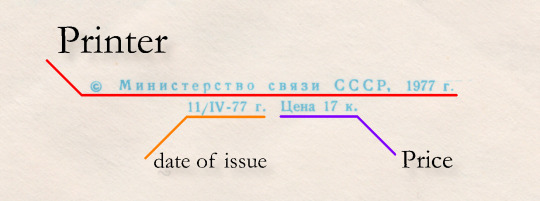
The thing on this envelope
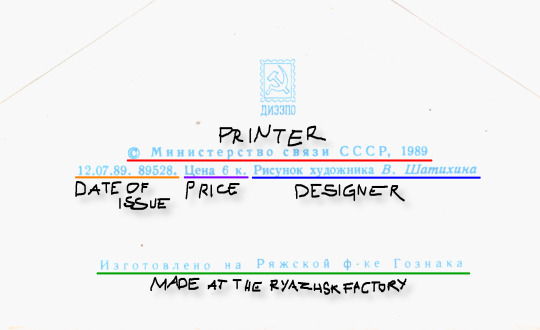
The thing on the cover from day 5 (Sorry it's a bit hard to write with a mouse)
So thanks to Soviet standards, I and now you(!) can tell this envelope was issued on the 11th of April 1977.

Lets now talk about the cachet on this cover. The cachet features the Tupolev-154, a jet airliner produced by Tupolev in The Soviet Union and then The Russian Federation. It shouldn't be confused with the Tupolev-144, the (mostly) forgotten first supersonic jet airliner. It's first flight was about 2 months before the Concorde, and entered service less than 1 month before the Concorde, in December 1975. And the first passenger service (Between Moscow and Alma-Ata) in November 1977, but due to it being horribly designed, it wasn't very popular; reportedly you had to yell to the person for them to hear you, because the engines were so loud, even if they were sitting right next to you, and if they were sitting 2 seats away from you, you couldn't hear them even if they were screaming and the only way to communicate was by passing handwritten notes (Source), and it wasn't very nice to ride on them. That led to passenger services being cancelled only 7 months later on 1st of June 1978. But they remained in production until 1983, and were used by The Soviet Millitary , Soviet Space Program(Late 80s), and NASA (Until 1999!).
Oops I went on a bit of a tangent there. The TU-154 was produced from 1968 up until 2013(!), over a thousand were produced and are still in use by for passenger services in North Korea (They are predictably the only passenger user left), For millitary service in Russia, China and Kazakhstan, and Goverment service in Kyrgystan.
Of course being one of the most produced jet airliners ever, quite a lot of accidents and incidents have happened with TU-154's (110 accidents) for a total of 2911 fatalities. Moje Sožalje/My condolences.
Welp, Here's the full mint unhinged cover, in all it's glory
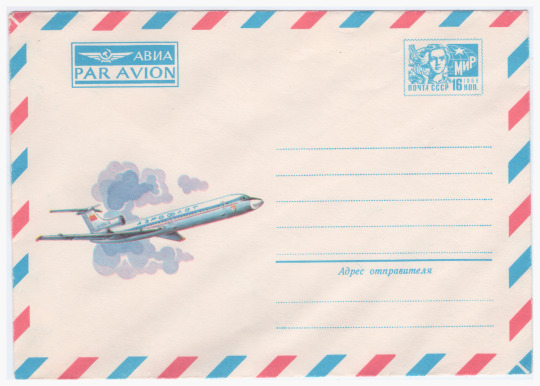
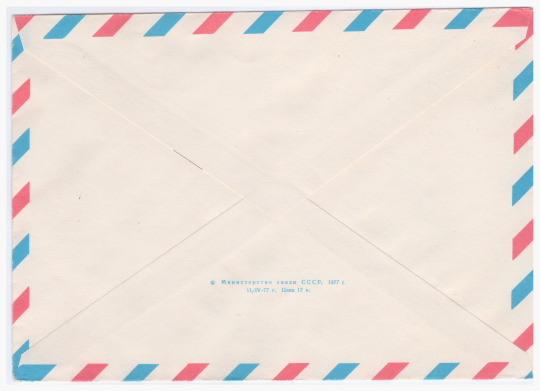
Wow, look at it, isn't is preetee??????
Oh yeah, we have another cover to talk about. You may have asked yourselves 'How did you chose which two covers to add?'. Well its pretty self explanatory, it's a postally used version of the same envelope sent on the 23rd of March 1981 from Vilnius, Soviet Lithuania to Marbella, Spain. It was also uprated to 32 Kopecks with a 1961 16 kopeck stamp.
I dont have anything else to say so... HERES THE COVER
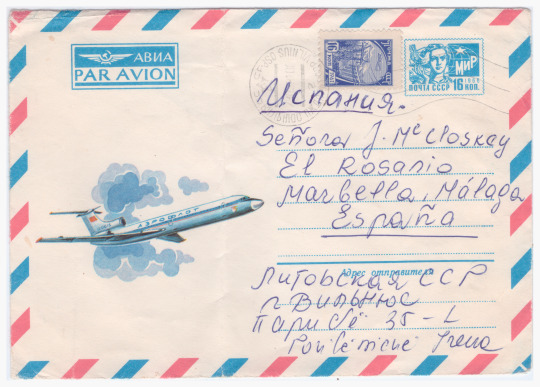

P.S. Wow this was a lot longer than I expected. Don't expect other posts to be this long, sorry.
#covers#philately#postal stationary#soviet union#hotduck.gif#tupolev#tu 144#tu 154#2 to the power of 3#is this how tags work#oh hell yeah#bye now
0 notes
Text

Russian Air Force Tu-154 at Dyagilevo Air Base
23 notes
·
View notes
Text
this happened in poland
On 10 April 2010, a Tupolev Tu-154 aircraft operating Polish Air Force Flight 101 crashed near the Russian city of Smolensk, killing all 96 people on board. Among the victims were the president of Poland, Lech Kaczyński, and his wife, Maria; the former president of Poland in exile, Ryszard Kaczorowski; the chief of the Polish General Staff and other senior Polish military officers; the president of the National Bank of Poland; Polish government officials; 18 members of the Polish parliament; senior members of the Polish clergy; and relatives of victims of the Katyn massacre
What happens to a company if every executive dies in a fire and every board member is incapacitated like in a coma or actually maybe they just refuse to show up to the board meetings and no one knows why. But it's like a big company, Microsoft etc., and all the day to day employees and shit and the low level managers are fine. Theoretically it could keep going.
79 notes
·
View notes
Text
Boeing 757 and Russian Tu-154, Mid Air Collision, After Few Minutes Take-Off From Sochi. All 71 People on Board are Dead, TechoAir Hindi.

0 notes
Text
Events 2.12 (after 1950)
1961 – The Soviet Union launches Venera 1 towards Venus. 1963 – Construction begins on the Gateway Arch in St. Louis, Missouri. 1963 – Northwest Orient Airlines Flight 705 crashes into the Everglades shortly after takeoff from Miami International Airport, killing all 45 people on board. 1966 – Rabbi Morris Adler is fatally shot by a disgruntled congregant at Congregation Shaarey Zedek in Southfield, Michigan, United States. 1965 – Malcolm X visits Smethwick near Birmingham following the racially-charged 1964 United Kingdom general election. 1968 – Phong Nhị and Phong Nhất massacre. 1974 – Aleksandr Solzhenitsyn, winner of the Nobel Prize in Literature in 1970, is exiled from the Soviet Union. 1983 – One hundred women protest in Lahore, Pakistan against military dictator Zia-ul-Haq's proposed Law of Evidence. The women were tear-gassed, baton-charged and thrown into lock-up. The women were successful in repealing the law. 1988 – Cold War: The 1988 Black Sea bumping incident: The U.S. missile cruiser USS Yorktown (CG-48) is intentionally rammed by the Soviet frigate Bezzavetnyy in the Soviet territorial waters, while Yorktown claims innocent passage. 1990 – Carmen Lawrence becomes the first female Premier in Australian history when she becomes Premier of Western Australia. 1992 – The current Constitution of Mongolia comes into effect. 1993 – Two-year-old James Bulger is abducted from New Strand Shopping Centre by two ten-year-old boys, who later torture and murder him. 1994 – Four thieves break into the National Gallery of Norway and steal Edvard Munch's iconic painting The Scream. 1999 – United States President Bill Clinton is acquitted by the United States Senate in his impeachment trial. 2001 – NEAR Shoemaker spacecraft touches down in the "saddle" region of 433 Eros, becoming the first spacecraft to land on an asteroid. 2002 – The trial of Slobodan Milošević, the former President of the Federal Republic of Yugoslavia, begins at the United Nations International Criminal Tribunal for the former Yugoslavia in The Hague, Netherlands. He dies four years later before its conclusion. 2002 – An Iran Airtour Tupolev Tu-154 crashes in the mountains outside Khorramabad, Iran while descending for a landing at Khorramabad Airport, killing 119. 2004 – The city of San Francisco begins issuing marriage licenses to same-sex couples in response to a directive from Mayor Gavin Newsom. 2009 – Colgan Air Flight 3407 crashes into a house in Clarence Center, New York while on approach to Buffalo Niagara International Airport, killing all on board and one on the ground. 2016 – Pope Francis and Patriarch Kirill sign an Ecumenical Declaration in the first such meeting between leaders of the Catholic and Russian Orthodox Churches since their split in 1054. 2019 – The country known as the Republic of Macedonia renames itself the Republic of North Macedonia in accordance with the Prespa agreement, settling a long-standing naming dispute with Greece.
1 note
·
View note
